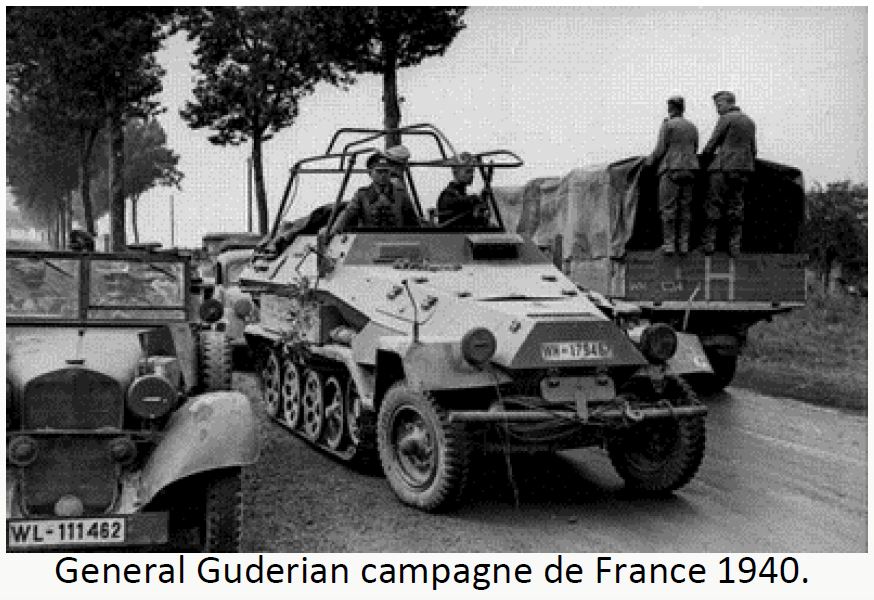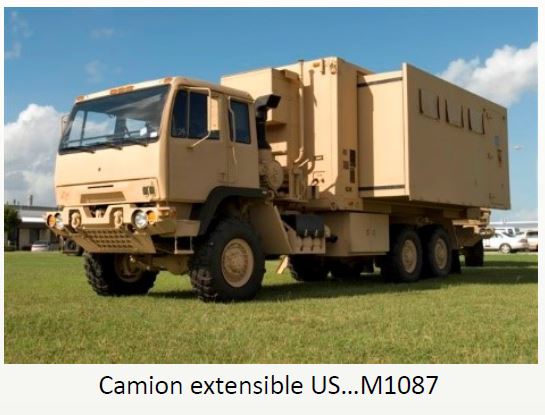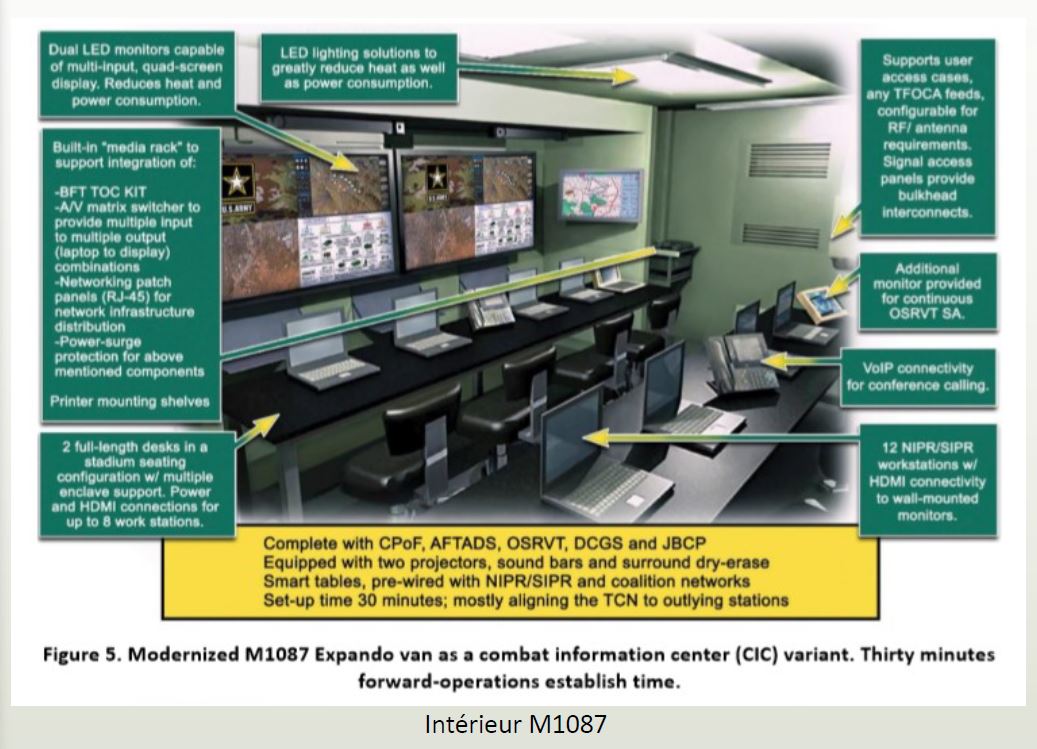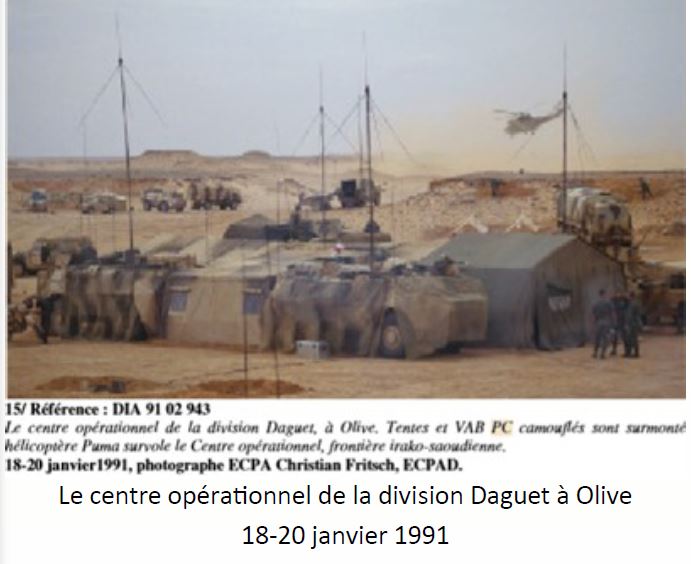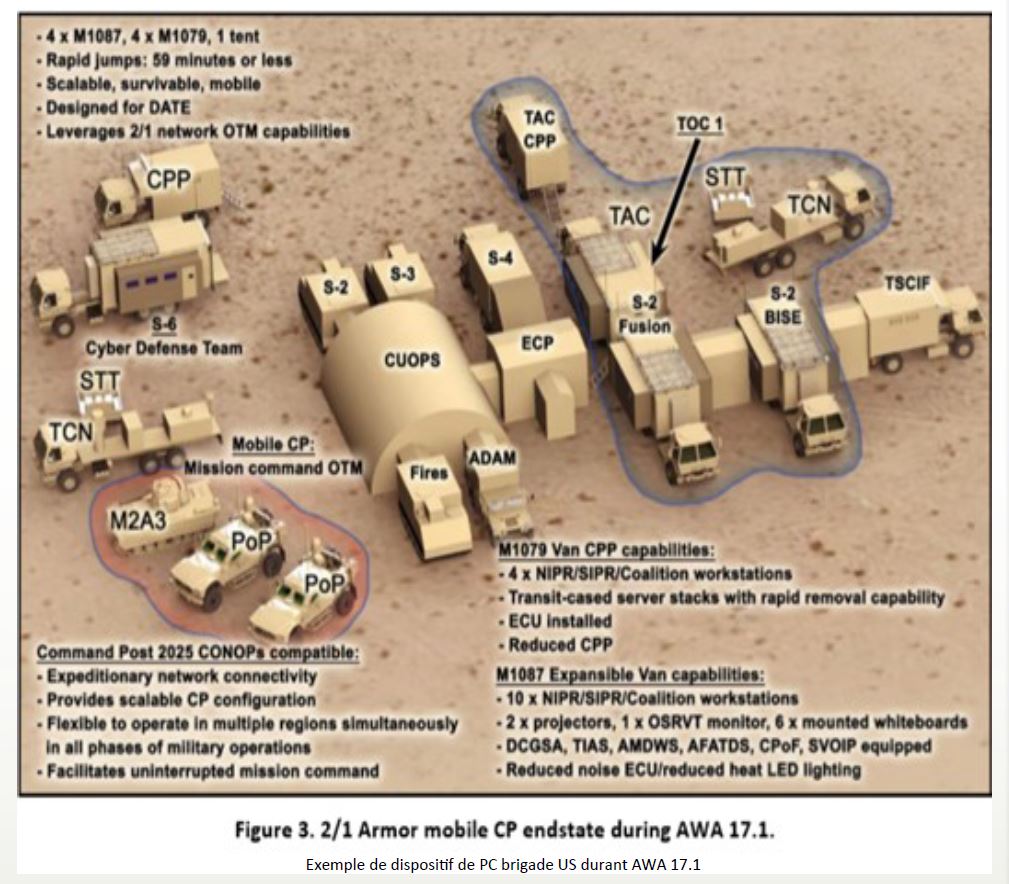Mobility of command posts and command post systems
At a time when the French armies have long since committed only expeditionary land forces that are tailored to the needs of the enemy, most often asymmetricalIt is difficult to imagine what the command post system of a force at the division or corps level could be. The last experience of a large-scale land engagement dates back to the Gulf War in 1991, when the DAGUET Division Command Post (CP) was divided between two COs [1] (red and green).
Although well-established know-how existed in the not-so-distant past, the absence or even decline of open terrain training, the reduction in material and human resources has led to a decline in the number of personnel and equipment available for such operations.The absence or even decline of open terrain training, the reduction of material and human resources dedicated to headquarters and the material difficulties of accommodation and food on the training grounds have gradually eroded them despite their digitalization.
Now France, which intends to have the first European army, has become aware that a return to major conflicts against a "peer to peer" or asymmetric enemy, but able to obtain tactical superiority locally and punctually, is once again a possible hypothesis. Based on a study on the movements of General Guderian's CP during the Polish and French campaigns, this article aims to ask questions related to the mobility of our CPs in the current environment, with the latest available technologies, and to provide answers in a first approach.
Study of the mobility of CPs in history
The Second World War is an essential medium of study since it is one of the last models of warfare where one can consider both the symmetry of the adversaries and the high intensity. The Korean War, the Yom Kippur War, or the last Iraq War could certainly bring interesting elements, but the lack of sufficiently reliable sources does not allow an in-depth study on CP mobility.
While most military history books focus on the movements and operations of units, few address the issue of command in any detail. General Guderian, whose tactical power is indisputable, provides in his memoirs rare details on the movements of his CP and its modus operandi. In this study, the author studied three periods of the Polish and French campaigns, while Guderian was corps commander (19°AK).
These elements can be schematized in the following tables:
|
Successive locations of the CP |
Zahn |
Grudziads |
Finckenstein Castle |
|
Date |
September 1, 1939 |
September 5, 1939 |
September 6, 1939 |
|
Distance to previous PC (as the crow flies) |
0 |
80 km (50 miles) |
54 km |
This phase is characterised by a high stability of the command post, which is explained by the shallowness of the Danzig corridor and the relative hardness of the first contacts with the Polish forces. In addition, there was a period of hesitation among the German troops, who were experiencing their first trial by fire.
Guderian, who was always on the front line, faithful to his favourite axiom "Bourrer and not baguenauder" (this will remain his "trademark"), was obliged to intervene personally in the manoeuvres of subordinate units, sometimes up to regimental level. His personal action, which today would be described as entryism, then allows to relaunch the action and give the soldiers "from the heart to the work".
They feel "commanded" by a leader who takes risks. We find here the image of the military leader, conceiving the manoeuvre and not hesitating to lead it in the field, which has left its mark on minds and history. From Napoleon to Marshal Leclerc, most of the great recognized military leaders have demonstrated bravery on the battlefield, combining tactics, courage and decisiveness.
Polish Campaign, Second Phase
|
Successive locations of the PC |
Orzysz |
Korzeniste |
Wizna |
Wysokie Mazowieckie |
|
Date |
September 8, 1939 |
September 9, 1939 |
September 9, 1939 |
September 10, 1939 |
|
Distance to the Previous PC as the crow flies |
0 |
54 km |
30 km |
34 km |
----------------------------------------------------------------------------------------------------------------------
|
Successive locations of the PC |
Bielsk Podlaski |
Kamaniets |
Brest |
|
Date |
September 12th 1939 |
September 15, 1939 |
September 17, 1939 |
|
Distance to previous PC as the crow flies |
49 km |
60 km |
34 km |
If the first time of the maneuver covers only 130 km, this second ten-day phase shows a movement of the 19th Corps (3rd Panzer, 10th Panzer, 20th DIM [2]) over an amplitude of 261 km. Guderian presents himself only on rather short periods at his command post; he moves from division to division with what he calls his command echelon. He also boasts of being "... the first Lieutenant General to use armoured command cars to accompany my tanks on the battlefield". These vehicles were equipped with radio equipment and provided a permanent link with the corps headquarters and the divisions under my command.
French Campaign
|
Location of the PC |
Bitburg |
Rambrouch |
Neufchateau |
Bouillon front PC |
|
Date |
9 May 1940 |
May 10, 1940 |
11 May 1940 evening |
May 12, 1940 07:00 a.m. |
|
Distance between points as the crow flies |
0 |
52 km |
31 km |
27 km |
----------------------------------------------------------------------------------
|
Location of the PC |
The Chapel |
Sapogne and Feuchère |
Soize |
Villers Le Sec advanced PC |
|
Date |
13 May 1940 |
14 May 1940 |
16 May 1940 |
18 May1940 07h00 |
|
Distance between points as the crow flies |
32 km from Neufchateau |
19 km |
51 km |
42 km |
----------------------------------------------------------------------------------
|
Location of the PC |
Holnon Woods advanced PC |
Marle |
|
Date |
May 19th, 1940 |
May 19th, 1940 |
|
Distance between points as the crow flies |
25 km from Villers le Sec but 67 km from Soize |
23 km silk |
The 2nd Panzer Division reached the sea on the night of 20 May 1940 and the Battle of Dunkirk ensued. Guderian was relieved of his command on 17 May by General von Kleist, commander of the panzer group (equivalent to an army command), who accused him of having exceeded the orders of the high command (OKH [3]). But General von Rundstedt, commander of the group of armies, annulled this dismissal by imposing on Guderian the maintenance of his CA CP on the spot. In the aftermath, he authorizes him to continue forward reconnaissance. Guderian was not to be begged and therefore used an advanced CP. He even plays with internal intelligence: "The corps headquarters remained at its present location in Soize. A field telephone cable connected it to my forward headquarters, so that I no longer had to... The Corps CP remained at its present location in Soize; a field telephone cable connected it to my advanced CP, so that since I no longer had to use the radio at my new location, I could not be located by the direction-finding of the OKH and OKW listening services [4].
This first part shows that the movement of an army corps in the offensive has an impact on the movement of its PC. The elongations between the different positions oscillated between 30 and 50 km on average, which corresponded more or less to the range of the command radio posts which, it seems, oscillated around 40 km without mounting a large antenna and thus allowed a mobile advanced PC to stay in contact. With a large antenna, the range was around 130 or 140 km, but required a stability of deployment that prevented immediate movement. The range of the means of transmission seems to be the main reason for the PCs to move around. The latter were relatively sheltered since the conventional artillery had a limited range of 10 to 20 km (the German 150 mm had a range of 13 km, the French 105 mm Schneider of 1936 of 16 km [5]). Only the air force could, at the time, have represented a real danger for the Germans, as was the case for Guderian during the famous episode in Bouillon on 12 May 1940 wherein his PC installed in an inn, he was almost knocked out during an air attack by a hunting trophy (a boar's head) that was taken down by the violence of the explosions.
What is flagrant, however, is Guderian's major role as tactical commander, everywhere at once, having the situation explained to him by the division or regimental commanders, using the various heavy divisional CPs in his area to transmit the necessary information to the AC CP or to subordinates, when the range of his advanced CP was insufficient.
In his book, "Panzer on Europe", General von Senger also quickly made the choice to use an advanced CP, after having noticed that his main CP had difficulty in obtaining a true vision of the situation in contact. Dispelling the "fog of war", particularly dense at the front of the front, seems to be the first justification for this type of command post. A parallel can also be drawn with the organisation and operation of the CP system of the 2nd Armoured Division and the active role of General Leclerc in 1944-1945.
Questioning the mobility of CPs
What has really changed since 1940? Many of the capabilities of the symmetrical or even asymmetrical enemy are now potentially much more dangerous:
. the ability to detect and pinpoint a CP's position using electronic warfare. It seems impossible to escape even in depth (ROEM satellites). Some possibly adversary equipment could detect a PC up to a radius of 300 km. The Russian Borisoglebsk-2 complex would have a range of 150 km. The Krasukha-4 equipment could create a shield of invisibility for objects in the air and on the ground with a radius of 300 km;
. the ability to target and then destroy an objective in depth is now possible at thousands of kilometres by different means (air strike, cruise or conventional missile) or by more limited but equally formidable elements : drone (120 to 250 km), multiple or unitary rocket launchers (range of about 70 km), artillery (70 to 80 km with additional propulsion...), with a precision of a few meters;
. the possibility of combining these last two capacities, allowing extremely fast strikes between the moment of detection and the moment of strike ;
. Spetsnaz type units or any armed element inserted in an unfavourable population which could, with simple means, attack our CPs in depth (conventional weaponry, mortar, makeshift drone, IED etc.).
All these elements show that the aggression capabilities of a CP at the disposal of a potential enemy are nowadays considerably more powerful than during the Second World War. Whether through the use of space, air or electromagnetic means (including cyber), it is becoming increasingly difficult to escape the enemy's view. This is what has come to be known as the so-called "transparency of the battlefield". It is therefore understandable that we need to review the way we deploy our PCs. A heavy and static PC will inevitably be detected at one time or another and thus destroyed, unless it is sufficiently buried. A mobile PC will have a better chance of survival, but will not escape the threat entirely.
France has the will to become the first army in Europe. To achieve this, it has embarked on an ambitious project to replace its hardware with the SCORPION programme. Its Army has thus strengthened its arms and legs. But these sophisticated means require a particularly efficient head. In the event that French forces have to fight in a context where their superiority could be challenged, one might ask whether mobile PCs are necessary.
If one can envisage the use at army and corps level of fixed installations that are sufficiently buried [6], the question arises as to the mobility of CPs at levels 2 (division) and 3 (brigade). While the staffs of our brigades and regiments probably still remain sufficiently light and mobile, our divisional staffs have become seriously burdened both in terms of human resources and information systems. It currently takes several weeks to install it in a single block (at least this is what is played during the GUIBERT-type PC exercises [7] in recent years).
However, the division and brigade levels will always be caught in the maelstrom of tactical movements, whether offensive or defensive. It is moreover in the defensive and especially when the situation becomes critical that the CP must be able to move quickly. The history of the Second World War teems with examples of French [8] or Russian staffs captured by surprise, or even having fled just in time to escape capture or destruction, but at the price of abandoning their equipment and their means of command.
Is the division still considered as a tactical pawn capable of mobility? For the writer of this article, there is no doubt about it. In this respect, the division will always be able to manoeuvre in an increasingly complex tactical situation. Its CP will have to work to provide its leader with the best understanding of the situation and the best ability to plan and produce orders.
What solutions should be provided?
From what has been said above, it seems obvious that our command posts must adapt if they are to survive in a conflict where some or all of the threats mentioned above could arise.
To increase the chances of survival on the battlefield, several options can be considered. Either distribute the CP in a linear fashion into several entities, or disperse its various components or even a mixture of the two. The current options are more in the direction of the first solution and are finally quite close to the study mentioned on Guderian's action.
For the division[9] , a main CP, one or two front (asset-passive) CPs, and the permanent possibility of deploying a tactical CP is thus envisaged. For the brigade headquarters, three options remain to be tested: a single headquarters, two alternative or duplicate headquarters, and a distributed headquarters (main and contingency). Dispersal for the brigade is still being considered. Modern means of communication should ultimately make it possible to implement these different models.
The main or single PC will retain a certain "heaviness" in terms of footprint. As a result, it will have to remain beyond the maximum range of most of the enemy artillery vectors[10] and its jamming and detection means, i.e. about 100 kilometres from the contact zone. For divisional forward CPs, a new solution must be found. For the moment, our device is based on modular shelters (container type) equipped or tents, requiring necessarily a time of assembly, but nothing mobile.
Moreover, the transport capacities of these shelters are often limited by increasingly limited land vehicles. Already during the Second World War, British equipment, quite developed for the benefit of the chief, had been put in place. Rommel used one taken from the enemy. The rough interior allowed a few officers to look at their maps. In recent years, the Americans have used expandable vehicles and there are models on the market that can be expanded to 36 square metres in just a few minutes, making it possible to have the entire installation (furniture, cabling, etc.) immediately available inside.…).
During an exercise in the United States AWA 17-1[11] in 2016, the Americans worked on the vulnerability of their brigade headquarters based on the following principles:
- it looked too much like a PC (11 inflatable tents);
- it was too big;
- it was too long to set up (10 to 20 hours needed);
- it required too much manpower and transport;
- it used too much energy.
After study, they reduced the 17 tents to one by replacing them with extensible trucks. After several tilts during the exercise, they reduced the set-up time from 18 hours to 2 hours, which still seems excessive for a PC. More recently, they have launched a programme of "FORCE 2025" objectives with a budget of approximately $3 billion over 5 years for 3 corps, 18 divisions and 56 joint brigades (combat team brigade), with, for example, the following ambitions:
. assembly or disassembly of a Corps-level PC in 1 hour ;
. assembly or disassembly of a Brigade-level CP in 30 minutes ;
. reducing the number of generators in a Brigade CP from 70 to 4.
This solution has drawbacks, as staff personnel are in a limited area and an environment that can quickly become very noisy. The presence of a generator mounted on these trucks contributes to this discomfort. Nevertheless, a planning group rarely has a larger space to work in and our former IPMAs[12] did not necessarily offer more.
Taking a front divisional PC from a class of 80 to 90 personnel, one can imagine housing them in six or seven trucks, an average of 12 per space. With this solution, multiplying limited PCs would encourage the mimicry of PCs of different levels and thus make deployments less legible for the adversary.
At a later stage, once the first step has been mastered, consideration could be given to the creation of mini PCs in addition to the PCs, which would be responsible for disappointment. An effort should also be made on means of rapid camouflage, on limiting radiation, on close protection and on rules for the protection and use of Information Systems Security (ISS), in particular those relating to the use of mobile phones and connected objects.
In conclusion, the prospect of major conflicts militates in favour of a return to much more demanding training and the opportunity to test new organisations. It would thus be useful to test in open terrain a divisional manoeuvre in the face of a well-represented enemy, while looking at what electronic warfare and UAVs really bring to the transparency of the battlefield. These sensitive elements would be extremely useful in drawing serious conclusions about our PC systems.
In addition, an initial study could be based on simulation. The new organisations and the dispersal of CPs will have an impact on the processes currently in force within command posts, leading to a questioning of the way of working. A period of learning and "agile planning" should gradually make it possible to find the most effective solutions.
It will probably also be useful to re-examine the functions that are strictly necessary at each level of command post (corps, division, brigade) in order to lighten them; a capacity adaptation will inevitably be necessary. However, whatever the solution chosen in the end, the part(s) outside the rear or main CP will have to rest on wheels, which will make it possible to gain in reactivity. The mobility of PCs is certainly only one of the aspects to be studied for the future Command and Control (C2), but it is crucial. A PC caught under fire could thus quickly stall and, despite inevitable losses, it might be possible to save enough to continue to conduct the manoeuvre. This mobility would also make the friendly device much less readable to the adversary. SCORPION combat would probably need to be much more mobile, while still providing the necessary dispersion to avoid providing too obvious a target. The studies of the SCORPION laboratory, which will begin this year to look at the impact of the programme on brigade CPs and the progressive inclusion of new information and communication systems, should provide some answers to this question of CP mobility.
—————————
1] OC: operations centre.
2] Motorised Infantry Division.
3] Ober Kommando des Heeres: high command of the army.
4] Ober Kommando der Wermacht : High Command of the Armed Forces.
[5] The 155mm Great Power Filloux (GPF) model 1917 had a range of 19.5 km, the German 15cm Kanone 39 had a range of 24.7 km.
6] Older Cold War bunkers or use of older devices, such as the Maginot Line, which have undergrounds sufficiently developed to provide protection without the enemy being able to discern the exact position of the deployed command element. In addition, the deployed command element may use multiple complexes.
7] A typical divisional level CP exercise within the Land Forces, designed to train, evaluate and control the staffs serving there.
8] During the French campaign, Rommel captured 277 guns, 458 tanks, 5,000 trucks, 97,468 prisoners, four divisional commanders and their staffs, in addition to 277 guns.
9] The French Corps CP, because of its current heaviness, will have to find a reasonable solution. In this article, the editor deliberately focused on levels 2 and 3.
10] And also benefit from a capacity to neutralize the ground-to-ground missiles of the enemy thanks to a ground-to-air artillery with radars and interceptor missiles.
11]https://www.benning.army.mil/armor/eARMOR/content/issues/2017/Summer/pdf/3LombardoEtAl17.pdf
12] Modular command post shelter.






